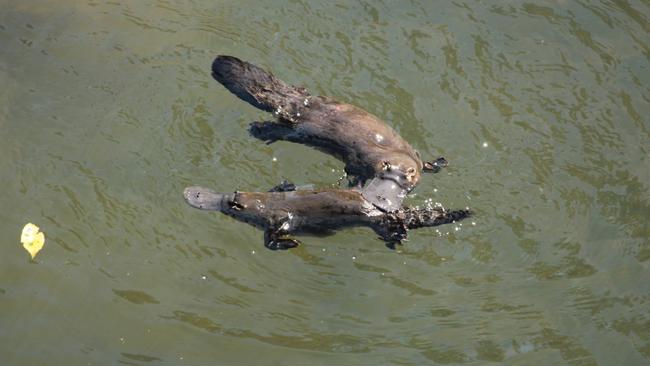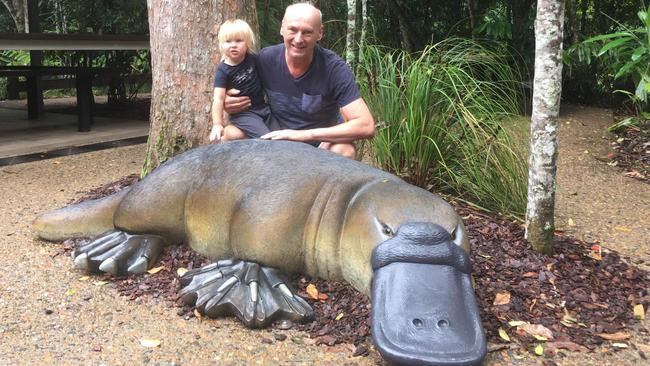Platypus under threat from Pioneer-Burdekin pumped hydro project
The drive to implant a gigantic energy storage system in the picturesque Pioneer Valley is speeding ahead without any clear idea of how many platypus might be affected.
Business
Don't miss out on the headlines from Business. Followed categories will be added to My News.
As work ploughs ahead on a massive $12bn energy storage project west of Mackay, residents and experts are sounding the alarm about how it might crush a beloved national icon: the platypus.
Drilling for the 5GW pumped hydro scheme has already begun even as the government acknowledges it does not know how many platypus are in the area or where.
Dalyrmple Heights resident Douglas Cannon said the state government’s WildNet data system for logging fauna failed to capture the full platypus population in the Pioneer Valley, the proposed location for the scheme.
“It doesn’t show platypus in the footprint of the pumped hydro system,” Mr Cannon said.
“But speak to locals up here, it is a well-known fact they (platypus) exist.”
He said platypus were regularly spotted at Dalrymple Heights and Netherdale, but WildNet shows just one sighting at Dalrymple Heights and none for Netherdale.

The scheme would involve two upper reservoirs at Dalrymple Heights and link them with a lower reservoir at Netherdale via an underground tunnel.
Platypus Lodge Restaurant and Cafe owner Oskar Krobath said platypus were “definitely more widespread” than their famed Eungella habitat.
“I have been living up here almost 20 years and pretty much from all the farming community, up at Dalrymple Heights and Crediton, they all come back to me and say they have platypus in their dams,” Mr Krobath said.
But despite local expertise, the government is driving ahead without a clear idea of how the project might affect the quirky billed animal.
Queensland Hydro, the public entity charged with delivering the project, says in its Platypus Management Plan that only “limited field assessments have been conducted for aquatic ecology values associated with Pioneer-Burdekin.”

More extensive surveys are expected to begin in mid 2023.
The plan also states the project will overlap with platypus habitats and the build could lead to habitat loss and degradation and modified waterways.
“Platypus face multiple threats with key potential impacts principally linked to threatening processes including direct disturbance, land clearing and creation of dams that disrupt the natural water flow,” the document states.
It further states potential impacts will be “localised” and “appropriate measures” could significantly reduce any harm.
A spokeswoman for Energy Minister Mick de Brenni said more data would be collected on the platypus in coming months.
“The Minister’s office is advised that WildNet will not be used as a single point-of-truth and additional data sources, including ecological field surveys, consultation with platypus specialists and observations from local residents will be engaged to determine and assess any impacts,” the spokeswoman said.

“Queensland Hydro has engaged with several leading platypus experts and has requested a proposal to conduct a comprehensive assessment of the local population.”
But as more investigations get underway, the government has already approved a six-month geotechnical drilling program at Dalrymple Heights, led by Mackay business Twin Hills Engineering and Drilling.
University of Queensland animal science researcher Dr Edward Narayan said drilling posed risks to the “sensitive” platypus.
“You are not drilling on a small space,” he said.
“This is a large-scale intervention.”

Mr de Brenni’s office has confirmed Twin Hills must adopt mitigation measures to limit its impact, including an erosion and sediment control plan, and all personnel involved in the project must comply with the platypus plan.
The spokeswoman said Queensland Hydro would supervise the drilling and an environmental specialist would also periodically inspect the site to verify measures were being followed.
Treasurer Cameron Dick last week trumpeted a $1bn allocation for the project in the 2023-24 budget, part of a broader $62bn plan to reconfigure Queensland’s energy system towards a renewables base.
Dr Narayan said the build’s massive scope would likely disturb the platypus, which hosts electrical receptors in its bill to sense the world around it.
“It’s like disturbing you from your sleep,” he said.
“That’s the biggest challenge that I see.

“I have studied the stress biology of animals and these guys are very sensitive to subtle changes in their environment.”
Dr Narayan cautioned the scientific community did not “know enough” about the animal and its exact population in the area was “anyone’s guess”.
For Mr Krobath, losing the platypus would be catastrophic to his tourism-centred business.
“There is no business for Broken River without the platypus,” he said.
“This place is known, all around the world, as the best place you can spot the platypus in their natural environment.
“Yes, people do come for the walks and everything, but people have to understand the main attraction is the platypus.”





